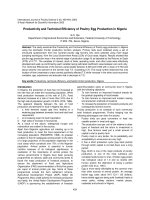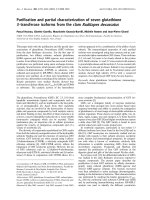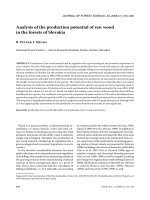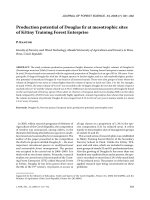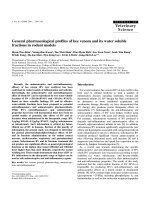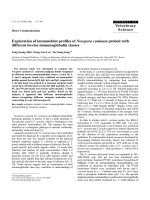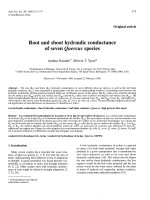Egg production profiles of seven traditional Hungarian chicken breeds
Bạn đang xem bản rút gọn của tài liệu. Xem và tải ngay bản đầy đủ của tài liệu tại đây (310.58 KB, 9 trang )
Europ.Poult.Sci., 78. 2014, ISSN 1612-9199, © Verlag Eugen Ulmer, Stuttgart. DOI: 10.1399/eps.2014.XX
Europ.Poult.Sci., 78. 2014, ISSN 1612-9199, © Verlag Eugen Ulmer, Stuttgart. DOI: 10.1399/eps.2014.XX
Egg production profiles of seven traditional Hungarian chicken breeds
Verlauf der Legeleistung bei sieben einheimischen. ungarischen Hühnerrassen
T.N. Lan Phuong, I. Barta, L. Bódi, K.D.T. Dong Xuan, J.N. Kovács, T.R. Ferencz and I.T. Szalay
Research Centre for Farm Animal Gene Conservation (HáGK); Association of Hungarian Small Animal Breeders for Gene Conservation (MGE)
Correspondence:
Manuscript received 24 July 2014, accepted 3 October 2014
Introduction
Family poultry production, the sector in which local farmers and the rural population can be easily involved by both
st
scientific and economic approaches, still has a major importance in the 21 century, primarily in the underprivileged
regions of developing countries (GUÉYE, 2000; ALDERS and PYM, 2009). Also, the native, traditional chicken breeds
are accepted as potential materials that may clue family farming to genetic conservation programmes. In general,
they contribute in many different ways to sustainable agricultural production (GUÉYE, 2002; HODGES, 2006; BODÓ
and SZALAY, 2007; DONG XUAN and SZALAY, 2007; MTILENI et al., 2012). Until the beginning of commercial chicken
breeding, the local chicken breeds of different colours (white, speckled, yellow and partridge and naked neck
variants) had been wide-spread in Hungary. They were preferred not only for their relatively good egg production
under harsh conditions, but also for their excellent meat quality which come from the “seeking habit” of the birds,
scratching for food regardless of hot or cold weather (BALDY, 1954). At the beginning of 1960 s, the breeding
programmes and production of local breeds were replaced by commercial chicken hybrids. It resulted in fast decrease
of the population number of old Hungarian chicken breeds. Meanwhile, Transylvanian Naked Neck breeds became
endangered even earlier (BODÓ et al., 1990). Since 1973, all breeds and colour variants have been maintained as
official gene reserves (SZALAY, 2002; SZALAY et al., 2009). In Hungary, 7 native/old chicken breeds are registered by
the MGE (an official breeding organisation for old Hungarian poultry bred in Hungary) and kept by Hungarian
academic institutions and universities as in situ gene banks (SZALAY, 2002; SPALONA et al., 2007; SZALAY et al.,
2009). These breeds include Yellow Hungarian Chicken (YH), White Hungarian Chicken (WH), Speckled Hungarian
Chicken (SH), Partridge-colour Hungarian Chicken (PH), White Transylvanian Naked Neck Chicken (WT), Black
Transylvanian Naked Neck Chicken (BT) and Speckled Transylvanian Naked Neck Chicken (ST). Conservationists
claim that utilization of the local farm animal genetic resources in production must be one of the major concerns of
conservation, for which many characteristics, including production and reproduction traits of the conserved
populations should be monitored and well documented (HENSON, 1992; TIXIER-BOICHARD et al., 2009). Nonetheless,
very few studies about egg production characteristics of traditional Hungarian chicken breeds have been published
during the “conservation era”, and none of them describes and compares the egg production profiles of the breeds.
This paper, therefore, aims to describe the pattern and compare the egg production of seven traditional Hungarian
chicken breeds conserved at the gene bank of the Research Centre for Farm Animal Gene Conservation (HáGK),
located in Gödöllő, Hungary. Understanding the egg production profile of these traditional breeds may help to
improve the utilization of all the breeds in sustainable agriculture and rural development.
02.12.2014
1/9
Europ.Poult.Sci., 78. 2014, ISSN 1612-9199, © Verlag Eugen Ulmer, Stuttgart. DOI: 10.1399/eps.2014.XX
Material and methods
All data presented in this paper was recorded from 7 native/old Hungarian chicken breeds, including YH, WH, SH,
PH, WT, BT and ST, which hatched from in vivo gene bank nucleus flocks, collected from 2008 to 2012. In order to
determine the egg production profiles of seven breeds, different examinations were carried out. The first one took
place in 2008–2010, in which the whole set of data of egg production obtained in the first-laying period of the breeds
was studied in two subsequent generations (2008/2009 and 2009/2010). The second examination took place in 2010
–2012, in which the egg production of two subsequent laying periods (from January to June) of the same flocks
hatched in 2010 were compared. All the hens were kept under the same conditions with daytime access to open air
and treated with the same diet. As all nucleus flocks were hatched in May, egg production of the flocks started in late
autumn and proceeded until the middle of summer, which is the usual pattern for natural backyard poultry.
Therefore, birds produced eggs in the wintertime too. Consequently, no lighting and heating regimes were applied
throughout the egg production. The female/male ratio of each group was 7:1, according to the conservation rules of
MGE (SZALAY et al., 2009).
Statistical analyses
All data were processed by the version 20.0 of SPSS. Calculated egg/hen/day recorded in the first-laying period of
seven groups (breeds) was analysed by Levene‘s test and Kruskal-Wallis test. Levene's test is used to assess the
equality of variances. The Kruskal-Wallis test is a non-parametric test. It was performed on ranked data and assumed
that the observations in each group come from populations with the same shape of the distribution (IBM CORP,
2011). Paired-sample T-test was used to determine whether there is a significant difference between the average
values of egg production in the two subsequent laying periods of each breed.
Results
The number of eggs/hen/collecting period and eggs/hen/day was consistently high in WH and YH breeds, and
consistently low in ST chicken breed (Table 1). All hens of the 7 breeds, hatched in May, started to lay eggs in
October, and ended in June of the following year. Interestingly, in 2009–2010, most of the breeds, apart from the ST
chicken, showed similar egg producing pattern over the laying period (Figure 1). It was observed that the laying cycle
of these breeds was divided into two sub-periods, in which the number of eggs increased till a particular value and
then dropped, which resulted in the formation of a 2-hill appearance. The trend line of ST chicken breed showed only
one peak in April-May with a steep increase, starting from December. All the Transylvanian hens tended to produce
much fewer eggs during wintertime (October-February) than the other groups (Figure 1). The difference between egg
production during winter and spring was not clearly demonstrated in YH, SH, WH and PH chicken breeds.
02.12.2014
2/9
Europ.Poult.Sci., 78. 2014, ISSN 1612-9199, © Verlag Eugen Ulmer, Stuttgart. DOI: 10.1399/eps.2014.XX
Table 1. Egg production of 7 traditional Hungarian chicken breeds in 2008–2009 and 2009–2010
Legeleistung von 7 traditionellen ungarischen Hühnerrassen in den Jahren 2008–2009 und 2009–2010
Year
2008–2009
2009–2010
Breed*
Number of egg
collecting days
Eggs/hen/
collecting period**
Eggs/hen/
day***
p value of
eggs/hen/day
YH
220
100.18
0.455b
< 0.050
WH
220
103.72
c
0.468
SH
220
78.21
0.356a
PH
220
98.10
0.446g
WT
220
69.80
0.318f
BT
220
70.16
0.320e
ST
220
69.18
0.316d
YH
233
115.14
0.493b
WH
233
95.20
c
0.410
SH
233
81.33
0.349a
PH
233
60.62
0.262g
WT
233
74.73
0.321f
BT
233
76.30
0.327e
ST
233
62.15
0.269d
< 0.050
* Yellow Hungarian chicken (YH), White Hungarian chicken (WH), Speckled Hungarian chicken (SH), Partridge coloured Hungarian chicken
(PH), White Transylvanian Naked Neck chicken (WT), Black Transylvanian Naked Neck chicken (BT), Speckled Transylvanian Naked Neck
Chicken (ST)
** Informative data without statistical analysis
*** a, b, c, d, e, f, g: different superscript letters show significant differences (p < 0.050) between groups
02.12.2014
3/9
Europ.Poult.Sci., 78. 2014, ISSN 1612-9199, © Verlag Eugen Ulmer, Stuttgart. DOI: 10.1399/eps.2014.XX
st
Figure 1. Eggs/hen/day of two subsequent generations of 7 Hungarian chicken breeds in the 1 laying period (2008–2009 and 2009–2010)
Yellow Hungarian chicken (YH), White Hungarian chicken (WH), Speckled Hungarian chicken (SH), Partridge coloured Hungarian chicken
(PH), White Transylvanian Naked Neck chicken (WT), Black Transylvanian Naked Neck chicken (BT), Speckled Transylvanian Naked Neck
Chicken (ST).
Eizahl/Henne/d in der ersten Legeperiode in zwei aufeinander folgenden Generationen von 7 ungarischen Hühnerrassen (2008–2009, 2009
–2010)
Gelbes ungarisches Huhn (YH), Weißes ungarisches Huhn (WH), Gesprenkeltes ungarisches Huhn (SH), Rebhuhnfarbiges ungarisches Huhn
(PH), Weißer Transylvanischer Nackthals (WT), Schwarzer Transylvanischer Nackthals (BT), Gesprenkelter Transylvanischer Nackthals
(ST)
From 2011 to 2012, number of eggs produced in the 1st and the second-laying periods was recorded (Table 2). The
significant difference between the two subsequent laying periods of the same flocks was found only in SH, WH, ST,
and BT chicken breeds. However, age effect on these chicken breeds was not the same (Figure 2). The ST and BT hens
produced significantly higher number of eggs/day during the 2nd laying period than during the 1st one (0.306 vs.
0.416, p < 0.050 and 0.319 vs. 0.379, p < 0.050, respectively). On the contrary, the SH and WH hens laid a
02.12.2014
4/9
Europ.Poult.Sci., 78. 2014, ISSN 1612-9199, © Verlag Eugen Ulmer, Stuttgart. DOI: 10.1399/eps.2014.XX
significantly lower number of eggs during their 2nd laying period as compared with their 1st laying period (0.459 vs.
0.386, p < 0.050 and 0.427 vs. 0.384, p < 0.050, respectively).
st
nd
Table 2. Egg production of 7 traditional Hungarian chicken breeds in the 1 and the 2
laying period in 2011 and 2012
Legeleistung von 7 traditionellen ungarischen Hühnerrassen in der ersten (2011) und zweiten (2012) Legeperiode
Breeds*
YH
WH
SH
Laying period
Number of egg
collecting days
Eggs/hen/
collecting period**
Eggs/hen/
day***
p value of
eggs/hen/day
1st
181
81.07
0.454
0.068
nd
2
182
89.58
0.473
1st
181
75.93
0.427a
nd
2
182
72.23
0.384
b
1st
181
82.13
0.459a
nd
182
75.18
b
0.386
1st
181
86.00
0.483
nd
182
96.23
0.49
1st
181
66.99
0.375
nd
2
182
73.82
0.375
1st
181
56.79
0.319a
nd
2
182
75.63
b
0.379
1st
181
55.14
0.306a
nd
182
77.21
b
2
PH
2
WT
BT
ST
2
0.050
< 0.050
0.475
0.956
0.050
< 0.050
0.416
* Yellow Hungarian chicken (YH), White Hungarian chicken (WH), Speckled Hungarian chicken (SH), Partridge coloured Hungarian chicken
(PH), White Transylvanian Naked Neck chicken (WT), Black Transylvanian Naked Neck chicken (BT), Speckled Transylvanian Naked Neck
Chicken (ST)
** Informative data without statistical analysis
*** a, b: different superscript letters show significant differences (p < 0.05) between groups
02.12.2014
5/9
Europ.Poult.Sci., 78. 2014, ISSN 1612-9199, © Verlag Eugen Ulmer, Stuttgart. DOI: 10.1399/eps.2014.XX
st
nd
Figure 2. Eggs/hen/day of the same flocks of 7 Hungarian chicken breeds in the 1 (2011) and the 2
(2012) laying period
Yellow Hungarian chicken (YH), White Hungarian chicken (WH), Speckled Hungarian chicken (SH), Partridge coloured Hungarian chicken
(PH), White Transylvanian Naked Neck chicken (WT), Black Transylvanian Naked Neck chicken (BT), Speckled Transylvanian Naked Neck
Chicken (ST).
Eizahl/Henne/d in der ersten (2011) und in der zweiten (2012) Legeperiode
Gelbes ungarisches Huhn (YH), Weißes ungarisches Huhn (WH), Gesprenkeltes ungarisches Huhn (SH), Rebhuhnfarbiges ungarisches Huhn
(PH), Weißer Transylvanischer Nackthals (WT), Schwarzer Transylvanischer Nackthals (BT), Gesprenkelter Transylvanischer Nackthals
(ST)
02.12.2014
6/9
Europ.Poult.Sci., 78. 2014, ISSN 1612-9199, © Verlag Eugen Ulmer, Stuttgart. DOI: 10.1399/eps.2014.XX
Discussion and Conclusion
Since the WH and YH breeds showed higher egg production than the others, these breeds would be preferred for free
range extensive and ecology oriented egg-farming systems. In this study, we also found that most of the traditional
Hungarian hens, being hatched in spring, produced a high number of eggs from March to May, whereas the opposite
was true in the beginning, between December and February and at the end of their egg production cycle. This
observation could be explained by the day length increase in spring (March-May) and decrease in December. Changes
of day length would stimulate the egg production of hens to rise and drop respectively. This observation is in
agreement with the previous studies of JACOB et al. (1998), OBAYELU and ADENIYI (2006) that only increasing natural
light would resume egg production. However, varied fluctuations during the egg laying period were obtained in
different traditional Hungarian chicken breeds. It confirmed the result found in the studies of OLAWUMI and
OGUNLADE (2013) that the performance in terms of egg production varies with seasons between breeds or strains.
Moreover, it was observed that the Transylvanian hens consistently produced much lower number of eggs in the
winter. Therefore, the study concluded that the Transylvanian chicken breeds are more sensitive to low temperature
than the other breeds. Regarding the number of eggs produced during the 1st and the second-laying period, this
study partly supported the results of JOYNER et al. (1987), JACOB et al. (1998), and SCHRIDER (2007) that the rate of egg
production reduced with increasing hen's age only in cases of SH and WH hens. On the contrary, the ST and BT
chicken breeds showed dissimilar results. In which, the rate of egg production increased with increasing hen's age.
No significant difference could be found in other breeds. The somewhat different and shorter breeding history of the
Transylvanian naked neck chicken breeds (BODÓ et al., 1990; SZALAY, 2002) may result in lower egg production in
the first and comparatively higher one in the subsequent production period. However, further investigation of age
effect on production and reproduction characteristics of traditional Hungarian chicken breeds is recommended.
This study concluded that genetic diversity of Hungarian chicken breeds based on microsatellite marker studies by
BODZSAR et al. (2009) can be observed in the different egg production patterns of the breeds, mainly between
Hungarian and Transylvanian Naked Neck breed groups. Presuming that the differences originate primarily from the
natural selection during their breed formation in the last decades, studies should be also undertaken to elaborate the
breeding conditions to the propagation of family poultry farming and other sustainable uses of all the breeds.
Summary
This paper aims to describe the pattern and compare the egg production of conservation flocks of seven traditional
Hungarian chicken breeds: Yellow Hungarian (YH), White Hungarian (WH), Speckled Hungarian (SH), Partridge
coloured Hungarian (PH), White Transylvanian Naked Neck (WT), Black Transylvanian Naked Neck (BT) and
Speckled Transylvanian Naked Neck (ST). Data were collected at the Research Centre for Farm Animal Gene
Conservation (HáGK). It was observed that egg production was comparably high in WH and YH and low in ST. The
Transylvanian hens produced fewer eggs during wintertime than the other groups. The egg-producing pattern of
hens hatched in spring showed similarity with two main hills in most of the breeds. The significant difference
between the 1st and the 2nd laying periods was found only in SH, WH, ST, and BT chicken breeds. The ST and BT
hens produced significant higher number of eggs/day during the 2nd laying period than during the 1st one (0.306 vs.
0.416, p < 0.050 and 0.319 vs. 0.379, p < 0.050 respectively). Meanwhile, the SH and WH hens laid a significantly
lower number of eggs during the second-laying period than during the first-laying period (0.459 vs. 0.386, p < 0.050
and 0.427 vs. 0.384, p < 0.050 respectively). Understanding the egg production of these traditional chicken breeds
may help to improve the utilization and involvement of not only the Hungarian chicken breeds with better
performance but also all the other breeds efficiently in family farming, as well as the other sustainable agricultural
production systems.
Key words
Hungarian chicken breeds, conservation, egg production, poultry genetic resources
Zusammenfassung
Verlauf der Legeleistung bei sieben einheimischen. ungarischen Hühnerrassen
Im vorliegende Beitrag werden das Legemuster von 7 traditionellen ungarischen Haushuhnrassen aus dem
Konservierungsprogramm beschrieben und deren Legeleistung verglichen: Gelbes ungarisches Huhn (YH), Weißes
02.12.2014
7/9
Europ.Poult.Sci., 78. 2014, ISSN 1612-9199, © Verlag Eugen Ulmer, Stuttgart. DOI: 10.1399/eps.2014.XX
ungarisches Huhn (WH), Gesprenkeltes ungarisches Huhn (SH), Rebhuhnfarbiges ungarisches Huhn (PH), Weißer
Transylvanischer Nackthals (WT), Schwarzer Transylvanischer Nackthals (BT), Gesprenkelter Transylvanischer
Nackthals (ST). Die Daten wurden im Forschungszentrum für die Erhaltung von Genreserven von
landwirtschaftlichen Nutztieren (HáGK) gesammelt. Die Legeleistung der Rassen WH und YH waren vergleichbar
hoch, während sie für die Rasse ST gering war. Die transylvanischen Hühner produzierten im Winter weniger Eier als
die anderen Rassen. Das Eiablagemuster der Hennen, die im Frühjahr geschlüpft sind, war ähnlich und zeigte bei den
meisten Rassen zwei Peaks. Es wurden nur für die Rassen SH, WH, ST und BT signifikante Unterschiede zwischen der
Legeleistung in der ersten und in der zweiten Legeperiode ermittelt. Die Hennen der Rassen ST und BT produzierten
in der zweiten Legeperiode signifikant mehr Eier/Tag als in der ersten (0,306 zu 0,416, P < 0,05 und 0,319 zu 0,379,
P < 0,05), während die Hennen der Rassen SH und WH in der zweiten Legeperiode signifikant weniger Eier legten
(0,459 zu 0,386, P < 0,05; 0,427 zu 0,384, P < 0,05). Das Wissen über die Legetätigkeit der traditionellen
Hühnerrassen kann nicht nur zu einer Verbesserung der Leistung der ungarischen Rassen verwendet werden,
sondern auch zur Weiterentwicklung anderer Hühnerrassen, die in Kleinfarmen verwendet werden, sowie anderer
nachhaltiger Produktionssysteme in der Landwirtschaft.
Stichworte
Ungarische Hühnerrassen, genetische Ressourcen, Konservierung, Eiproduktion
References
ALDERS, R.G., R.A.E. PYM, 2009: Village poultry: still important to millions, eight thousand years after
domestication. World’s Poultry Science Journal 65, 181-190.
BALDY, B., 1954: Baromfitenyésztés (Breeding of Poultry). Mezőgazdasági Kiadó, Budapest (in Hungarian).
BODĨ, I., I. SZALAY, 2007: Génbázisok megőrzése a fenntartható állattenyésztésben (Conservation of Genetic
Resources in Sustainable Animal Husbandry). Állattenyésztés és Takarmányozás 56 (5), 403-413 (in Hungarian
with English summary).
BODÓ, I., G. KOVÁCS, F. LUDROVSZKY, 1990: The Naked Neck Fowl. Animal Genetic Resources Information 7, 83-88.
BODZSAR, N., H. EDING, T. REVAY, A. HIDAS, S. WEIGEND, 2009: Genetic diversity of Hungarian indigenous chicken
breeds based on microsatellite markers. Animal Genetics 40 (4), 516-523.
DONG XUAN, K.D.T., I.T. SZALAY, 2007: Agricultural research for Development (ARD) – Trilateral HungarianVietnamese-Lao sample to develop poultry breeding in South-East Asia. Proc. 5th Vietnamese-Hungarian
International Conference on Animal Production and Aquaculture for Sustainable Farming, Can Tho University,
Can Tho, Vietnam, 11–15 August, 2007. 1-5 p. www.mge-hu.com.
GUÉYE, E.F., 2000: The role of family poultry in poverty alleviation, food security and the promotion of gender
equality in rural Africa. Outlook on Agriculture 29 (2), 129-136.
GUÉYE, E.F., 2002: Family poultry research and development in low-income food-deficit countries: approaches and
prospects. Outlook on Agriculture 31 (1), 13-21.
HENSON, E.L., 1992: In situ conservation of livestock and poultry. FAO Animal Production and Health Paper 99,
FAO, Rome and UNEP.
HODGES, J., 2006: Conservation of Genes and Culture: Historical and Contemporary Issues. Poultry Science 85 (2),
200-209.
IBM CORP, 2011: IBM SPSS Statistics for Windows, Version 20.0. Armonk, NY: IBM Corp.
JACOB, J.P., H.R. WILSON, R.D. MILES, G.D. BUTCHER, F.B. MATHER, 1998: Factors Affecting Egg Production in
Backyard Chicken Flocks. Fact sheet PS-35 of the Animal Sciences Department, Florida Cooperative Extension
Service, Institute of Food and Agricultural Sciences, the University of Florida.
JOYNER, J., M.J. PEDDIE, T.G. TAYLOR, 1987: The effect of age on egg production in the domestic hen. General and
Comparative Endocrinology 65 (3), 331-336.
02.12.2014
8/9
Europ.Poult.Sci., 78. 2014, ISSN 1612-9199, © Verlag Eugen Ulmer, Stuttgart. DOI: 10.1399/eps.2014.XX
MTILENI, B.J., F.C. MUCHADEYI, A. MAIWASHE, M. CHIMONYO, K. DZAMA, 2012: Conservation and utilisation of
indigenous chicken genetic resources in Southern Africa. World's Poultry Science Journal 68, 727-748.
OBAYELU, A.E., A. ADENIYI, 2006: The Effect of Climate on Poultry Productivity in Ilorin Kwara State, Nigeria.
International Journal of Poultry Science 5 (11), 1061-1068.
OLAWUMI, S.O., J.T. OGUNLADE, 2013: Strain by Season Interaction Effects on Production Traits of Commercial
Layers in the Derived Savannah Zone of Nigeria. International Journal of Agriculture and Bioscience 2 (2), 53-56.
SCHRIDER, D., 2007: Chicken assessment for improving productivity. American Livestock Breeds Conservancy,
Pittsboro, USA: 9-14.
SPALONA, A., H. RANVIG, K. CYWA-BENKO, A. ZANON, A. SABBIONI, I. SZALAY, J. BENKOVÁ, J. BAUMGARTNER, T.
SZWACZKOWSKI, 2007: Population size in the conservation of local chicken breeds in chosen European countries.
Arch.Geflügelk 71 (2), 49-55.
SZALAY, I., K.D.T. DONG XUAN, G. VIRÁG, K.Á. SZENTES, L. BÓDI, 2009: Prospects for conserving traditional poultry
breeds of the Carpathian Basin. Journal of Animal Welfare, Ethology and Housing Systems 5 (2), 119-148.
SZALAY, I., 2002: Régi magyar baromfifajták (Old Hungarian poultry). Mezőgazda Kiadó, Budapest, 111p (in
Hungarian and English).
TIXIER-BOICHARD, M., A. BORDAS, X. ROGNON, 2009: Characterisation and monitoring of poultry genetic resources.
World’s Poultry Science Journal 65 (2), 272-285.
Correspondence: Thieu Ngoc Lan Phuong, Isaszegi ut 200. H-2100 Godollo, Hungary; E-mail:
02.12.2014
9/9
